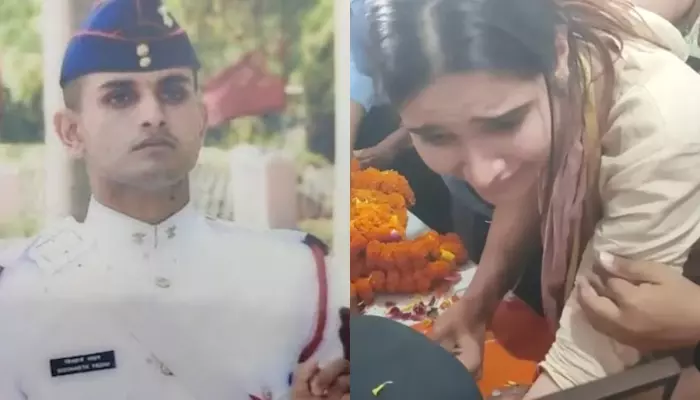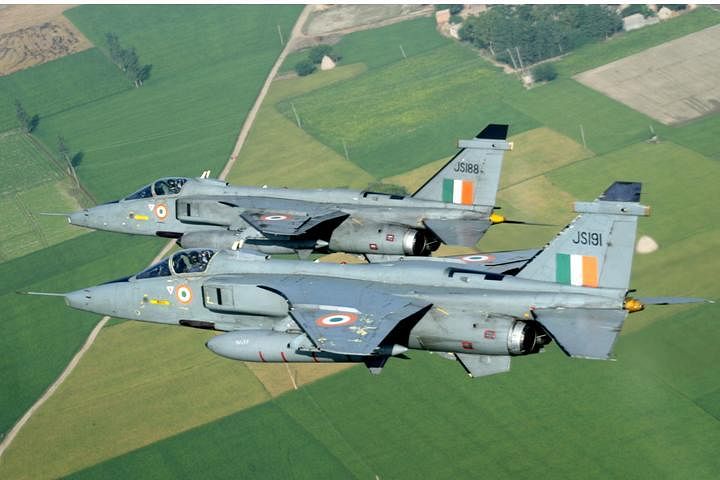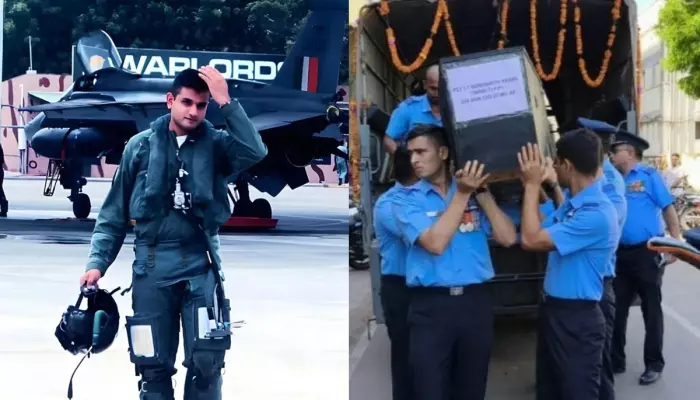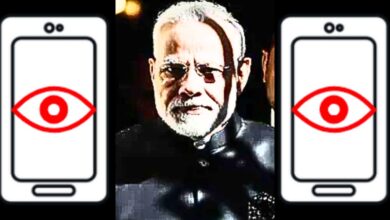Flying Coffins: The Silent Slaughter Of India’s Air Heroes– How Many More Pilots Should Die So That The Government Can Get Into Action?

In the peaceful town of Jaisalmer, on April 2, 2025, another youth joined India’s dead pilots. Flight Lieutenant Siddharth Yadav, just 28 years old, left this world not in glorious combat with an enemy but in the cockpit of an aircraft that should have been retired before he was born.
A Jaguar fighter jet, an outdated model from the 1970s, claimed another life, contributing to the tragic statistics that plague India’s aviation history in the military, although the Indian Air Force stated in an official report that “technical error” was the reason.
This tragedy is not a singular event. It’s merely another page in a tragic story that happens time and time again. The pattern is clear: a crash happens, a young pilot dies, people show their sadness, ceremonies take place, promises are made, and then; nothing. Until the next crash. Until the next funeral. Until the next family is left wondering why their loved one had to die, not in combat against the enemy, but in combat against the problems of their own government.
Can You Understand The Pain Behind This Mother’s Lament?
Maybe no one expresses this grief as eloquently as Kavita Gadgil, a 75-year-old mother who lost her son Flight Lieutenant Abhijeet Gadgil in a MiG-21 crash in 2001. After Yadav’s death, she went on Facebook with these words that pierced the din of nationalism and hollow guarantees:
“I want you to remember. Get angry. Ask for better. Don’t wait for the next accident to care,” she wrote. “Don’t just think of these boys at photo opportunities and patriotic hashtags, dear citizens of India, and another soldier is gone, Flight Lieutenant Siddharth Yadav. He wasn’t killed in war. He wasn’t killed in battle. He died in a 46-year-old Jaguar jet that should have been retired long before he was born. He died flying an airplane that the world quit using decades ago.”
Her words remind us that each number is a human being, a son, a brother, a fiancé, a friend, whose life did not die from enemy bullets but from government indifference. Yadav was just 10 days into his engagement when the accident occurred. He was not building a legacy of conflict; he was building a life. And we gave him, in Kavita’s words, “a coffin in the name of a cockpit.“

Since the death of her son in 2001, more than 340 IAF aircraft have crashed, and 150 pilots have lost their lives. “The numbers are appalling,” she says. “The silence on them, worse.”
The Legacy of Neglect By Our Government Towards Indian AirForce
The “Flying Coffin” is not a new name. In 1982, Parliament was discussing the large number of IAF accidents. They noted that peace-time accidents over two years had lost almost as many planes as were lost in the whole 1971 war. Committees have been constituted, reports have been submitted, and recommendations have been made for over forty years. The accidents still occur, the funerals are conducted, and the cycle of denial continues.
The MiG-21, the “Flying Coffin” and the “Widow Maker,” is a name of pain!
It was designed in the 1950s and first flew with the IAF in the 1960s. These planes are still flying here even though the majority of countries retired them years ago. When the Soviet Union fell, spare parts were hard to come by, maintenance was tricky, and these planes aged. Still, young pilots have been put in these old planes and told to “touch the sky with glory” – or die trying.
The Jaguar, the aircraft responsible for Yadav’s demise, is another piece of this tragic tale. It was added to the IAF fleet in 1979 and was a very modern aircraft at one time. It performed well in the IPKF mission in Sri Lanka (1987-1990), was India’s primary nuclear delivery platform in the early years of our nuclear program, and conducted accurate bombing in the 1999 Kargil War. But all that was long ago.
Now they are 46-year-old aircraft plagued with issues of metal fatigue, outdated electronics, and mechanical failure. However, a high attrition rate has stained the Jaguar’s operating career. According to Air CMDE (Retd) A.S. Bahal, by 2015, the fleet had already seen 50 crashes, resulting in the loss of 65 aircraft, or roughly 46% of the original fleet.
There are approximately 120 Jaguars still flying in the IAF fleet, while European countries phased out their fleets years ago. Their initial innovative low-flying feature, to fly below enemy radar, has now been made obsolete by advances in detection equipment. But instead of phasing out these aircraft in respect for their service and with the respect they deserve, we continue to keep them flying, and continue to bury the pilots who crash along with them.

The Government’s Response Involves Choosing Metrics Over Men
When faced with such tragedies, the government responds in a cold and detached way. In December 2024, the Parliament Standing Committee said that between 2017 and 2022, 35 fighter jets, combat helicopters, and transport planes crashed. Shockingly, 54% of the crashes were not caused by technical faults but by “human error”; a simple word that deflects the blame from the old equipment to the people who operate it.
The government likes to point to statistics showing improvement: from 0.9 crashes per 10,000 flying hours to 0.2 between 2020 and 2024. These statistics are designed to reassure us that things are improving. But statistics don’t cry. Percentages don’t go to funerals. And suffered families don’t take comfort in better statistics when their loved ones are being buried.
Behind these chilling statistics lies an unpleasant reality: India continues to lose its best pilots not due to enemy fire but due to sluggish government responses and misplaced priorities.
It is difficult to comprehend why the IAF continues to rely on outdated aircraft when contemporary warfare demands the latest technology, and our pilots deserve hardware matching their talent and toil.
How The Warnings Are Ignored?
The IAF top brass has not remained silent about this issue. Air Chiefs have repeatedly cautioned regarding the aging aircraft and the lagging modernization of the programmes.
Recently, in 2025, Air Chief Marshal AP Singh raised questions about whether Hindustan Aeronautics Limited (HAL) could meet the air force’s large needs. He had “no confidence” in the government-owned aircraft maker because of constant delays in the manufacture of new fighter jets. This was not the first.
A decade ago, in 2014, Air Chief Marshal Arup Raha had been worried about delays in the Medium Multi-Role Combat Aircraft (MMRCA) project, the indigenous Tejas light combat aircraft program, and the joint effort to develop a new stealth fifth-generation fighter aircraft with Russia.
These warnings are from the top echelons of the military flight community; from people who know the risks as well as or better than anybody. But, apparently, their warnings fall into the political quicksand of government, budget limitations, and bureaucratic inaction.
Art Imitates Life, And No One Learns
In a bizarre case of life imitating art, or art imitating life, the critically successful 2006 film “Rang De Basanti” had a plot in which Flight Lieutenant Ajay Singh Rathod (played by R. Madhavan) lost his life when his MiG-21 plane crashed due to tainted procurement procedures. The film initiated a national debate on the circumstances our fighter pilots have to endure and institutional malfeasance that can endanger them. But almost two decades later, it appears our ministers were too engrossed in debating “pakoras and startups” to watch the film or pay attention to the film’s warning.

Yadav’s death highlighted the connections between truth and fiction. Like the guy in the film, he died as a result of a system flaw rather than an act of violence. As the film shows, his death was not an unforeseen catastrophe, but rather the result of operating antiquated airplanes that were far past their prime. And as the movie also depicts, the response has been superficial more than making real changes.
The Jaguar had 50 crashes in 2015, 2-3 every year. These are not statistics; these are lives lost, funerals, and mourning families. Their careers are abbreviated, dreams are not realized, and potential is wasted. They are a national shame that is a necessary sacrifice.
The History Depicts A Pattern of Neglect Since Ages
The history of India’s military aviation has been tainted with a failure to invest in modernization and the habit of making use of equipment long after it was intended. It has been a pattern since independence began, not a recent phenomenon.
Post-independence, India employed British planes such as the Hawker Tempest, Spitfire, and later the de Havilland Vampire. As Cold War politics heated up, India began using Soviet equipment, like the MiG series, which comprised the majority of the Indian Air Force for decades. Although such planes were inexpensive and politically beneficial, they also had flaws, including maintenance problems, insufficient spares, and, eventually, obsolescence.
The 1970s and the 1980s introduced aircraft such as the Jaguar (Anglo-French), MiG-23, MiG-25, and MiG-29 (Soviet), which diversified the fleet but introduced maintenance complexity as well. The 1990s introduced economic liberalization and the collapse of the Soviet Union, introducing new challenges in the form of maintaining Soviet-era equipment.
There was a pattern that developed over time: India would buy aircraft, use them far longer than they were designed to be used, struggle with maintenance and spares, and then rush to replace them when it became too difficult. This short-term cost-saving approach cost lives in the long term.
In the early 2000s, the LCA Tejas project was plagued by delays. Tendering for MMRCA took years to come to the conclusion of selecting the Rafale. So long-drawn and contentious was the process that it became a political scandal rather than a military requirement.
Now, in 2025, we possess an air fleet of 1970s aircraft that are still in action, indigenous planes that are delayed, and imported planes stuck in red tape and politics. This is a recipe for perpetual trouble, and Flight Lieutenant Yadav is only the latest victim of this long-standing neglect.
The Global Comparison: How Other Nations Value Their Aviators And India Kills Them!
India’s strategy for maintaining military aviation safety and modernizing planes is quite different from how other big air forces in other parts of the globe do it. Smaller, lower-budget countries with smaller defense budgets have been more committed to protecting their pilots and possessing newer aircraft.
Israel has few people and few resources, but it possesses one of the finest air forces in the world. It adheres to very strict safety protocols and modernizes its aircraft frequently. The Israeli Air Force retires aircraft when they are no longer safe, not when they start breaking down. They realize that their pilots are extremely important and should not be threatened by flying old aircraft.
Smaller nations such as Sweden have also established their own fighter industries that produce sophisticated fighters such as the Gripen. This enables their pilots to fly with up-to-date and secure equipment without entirely relying on foreign producers. Even developing nations such as Brazil have spent money on equipment such as the Embraer Super Tucano for training. They realize that the safety of their pilots begins with adequate training in proper aircraft.
The United States, which spends so much more on the military, has strict controls on safety and has its aircraft refitted periodically. When American F-15s developed structural flaws in the 2000s, they were all withdrawn from service until the flaws were repaired – quite different from India’s habit of flying aircraft with known flaws.
Japan possessed old F-4 Phantom planes in the early 2000s. Instead of holding on to them for longer, they immediately decided to buy F-35s. Australia recently retired its F/A-18 Hornets after 35 years. They replaced them with F-35s even though the Hornets were still airworthy. They knew that just because an airplane can fly doesn’t mean it is a good idea to employ it in combat, and keeping pilots alive is very important.
The international context makes it even more difficult to understand why our country continues to fly 46-year-old Jaguars and vintage MiG-21s. It is not a matter of having sufficient funds but of having proper priorities; our politicians opt to put our best young officers’ lives at risk rather than investing in modernization.
The Human Toll Is More Than Just Statistics
Statistics only half reveal the tale. Behind every crash are shattered lives, families bereft of sons, fiancées bereft of partners, and children bereft of fathers. The human toll of these “technical faults” and “human errors” goes far beyond the cockpit.
Flight Lieutenant Advitiya Bal was killed when his MiG-21 crashed in July 2022 with Wing Commander M Rana. Bal was a boy from a small village in Jammu and was a pride of his community. He was a hard worker and was determined to become a fighter pilot. His father queried why young pilots were still flying “old” aircraft after he died. “My son wanted to serve the country, not die because of bad equipment,” he said to reporters.

Take the case of Squadron Leader Abhishek Choudhary, who was only 28 when his MiG-21 Bison crashed in May 2021 near Moga, Punjab. He was an excellent officer with a great career ahead. Choudhary had parents who had sacrificed everything for his education and working life. His son did not die protecting India’s air space; he died because India was not able to protect him from old technology.
Wing Commander Harshit Sinha was killed when his MiG-21 crashed at Jaisalmer while on a training exercise on December 24, 2021. His colleagues described him as a very competent pilot. His abilities were unable to save him from the limitations of a machine that had been designed years before he was born.
These are not just names on a roll call of people who died; their lives were abbreviated and maybe unfulfilled. Families are left wondering why their loved ones needed to die, not serving the nation, but because of its neglect.
The National Mindset: Respecting Efforts Rather Than Demanding More
One of the most repulsive things about this ongoing travesty is that we, as a nation, have started embracing and even celebrating such unnecessary sacrifices. People in India began romanticizing struggle as courage and celebrating pain rather than questioning the fact that pain exists in the first place.
- When a man carries his dead wife on his shoulders because there are no ambulances, we praise his love instead of asking for better healthcare.
- When people in Mumbai walk through flooded streets to get to work, we celebrate the “spirit of Mumbai” instead of asking for working drainage systems.
- And when young pilots die in old planes, we honor their sacrifice instead of asking for modern equipment that could have saved their lives.
This mindset isn’t unique to aviation; it’s a national trait that causes us to accept substandard conditions as unavoidable and not as modifiable. We’ve made resignation a virtue and acceptance a strength. We say it’s resilience, but is it really?
Ever since the dawn of flight, we have rewarded pilots for their courageous spirit. When the Wright brothers took to the air for the first time in 1903, they risked their lives in test aircraft constructed of wood and fabric. These risks were all part of the endeavor. During World War I, pilots were heroes of the air, and flying machines were hazardous for them just as they were for the enemy.
But that was then. In the beginning, flying was new, technology was rudimentary, and crashes were the norm. Today, a hundred years plus later, we have no reason not to do better. We have the knowledge, the technology, and the resources to give our pilots safe, modern airplanes. What we lack is the will to make it significant.
Every time a young officer like Yadav is killed in an old aircraft, we are not only lamenting his life but also ours for not moving forward. He was not a bad pilot; he was killed because we did not replace old technology with new ones. Being brave does not replace the need for improvement. When someone decides to fly a military aircraft, he is deciding to put his life at stake against outside attacks, not because we did not want to modernize our equipment.
The Bottom Line
The true tragedy is not that we’ve lost another good pilot, but that without radical change, we’ll continue to lose others. We’ll continue flying old aircraft, continue placing good people in impossible situations, and continue going through the motions of grieving without ever confronting the root problems.
Tradition is comfortable. It’s easier to say, “That’s the way it is,” than to ask, “How do we make it better?” Change is messy and costly. It takes admitting that the old way isn’t working, money, making tough choices, and sometimes having to say that we were wrong for many years.
If we really wish to pay respect to Yadav and all the pilots who have died under similar circumstances, we shouldn’t just be applauding their courage. We should change the system that let them down. We need not only upgrade planes, but also modify the way we think. We need to stop taking sacrifice as a given and start demanding better.
Above all, ‘WE, THE PEOPLE OF INDIA’ must change our responses to similar events.
- We need to go beyond candle marches and Facebook memorials.
- We must demand accountability, openness, and action.
- We need not accept the loss of our best young officers as a necessary price for having a defence force.
It’s easy to pay respects to the dead. It’s hard to improve the world so that fewer die. That is true progress. Anything less is all talk.
Thus, to Flight Lieutenant Siddharth Yadav and all the martyrs who preceded him, we say not only “Rest in Peace” but “We will do better.” Your deaths cannot be in vain. Your sacrifices cannot be accepted as the new norm. Your loss must bring about the change that has been too long in coming.
India cannot be said to be an emerging world power while putting its defenders in the air in flying coffins. We cannot expect respect on the world stage while displaying such little respect for the lives of our protectors. And we cannot claim to be a nation that respects its military while repeatedly failing to provide them with the tools they deserve.
The next time a minister speaks about fresh ideas, technology upgradation of the newest sort, or India’s increasing role globally, let us pose a question:
- Why do we continue to fly aircraft other nations discarded decades ago?
- Why is slow government response and paucity of funds higher priorities than the lives of our pilots?
- What are they doing to ensure Siddharth Yadav is the last pilot to get lost in an airplane as old as his father?
Kavita Gadgil said emphatically: “I don’t want your condolences… don’t salute their coffins and forget them in next week’s headlines… they deserved better than this. We owe them better…“
In fact, we do. And it’s been a long time since we paid that debt.




